Discover the secrets to Choosing the Perfect Yoga Mat for Your Practice with expert tips and advice. Find the best mat for your needs today!
Choosing the perfect yoga mat for your practice is more than just picking something that looks good. The right mat can enhance your practice, protect your joints, and even motivate you to step onto the mat day after day. Whether you’re a seasoned yogi or just starting out, understanding the various factors that go into selecting a yoga mat is crucial.
Why Your Yoga Mat Matters
The significance of choosing the perfect yoga mat for your practice cannot be overstated. A yoga mat is not merely a piece of equipment; it’s the foundation of your practice. The right mat provides support, stability, and comfort, which are essential for maintaining proper alignment and avoiding injury. Additionally, a good mat can absorb sweat, prevent slipping, and cushion your body during those long, intense sessions.
Yoga mats come in a variety of materials, thicknesses, and textures, all of which can significantly impact your practice. A well-chosen mat can help you focus better, maintain balance, and feel more connected to your practice. On the other hand, an ill-suited mat can lead to discomfort, distraction, and even injury. Therefore, investing time and effort into choosing the right mat is a step toward enhancing your overall yoga experience.
Types of Yoga Mats
Understanding the types of yoga mats available is the first step in choosing the perfect yoga mat for your practice. Yoga mats are generally categorized by the material they are made from, each offering different benefits. The most common materials include:
- PVC (Polyvinyl Chloride): Known for its durability and stickiness, PVC mats are widely used. They offer excellent grip and are relatively inexpensive. However, they are not eco-friendly and may contain toxins.
- TPE (Thermoplastic Elastomer): A more environmentally friendly option, TPE mats are lightweight, easy to clean, and offer good traction. They are, however, less durable than PVC mats.
- Natural Rubber: These mats are biodegradable and provide excellent traction. They are a great choice for those who prioritize eco-friendliness. However, they are heavier and may not be suitable for those with latex allergies.
- Cork: Cork mats offer a unique texture that provides excellent grip when wet, making them ideal for hot yoga. They are also eco-friendly and naturally antimicrobial.
- Jute: Another eco-friendly option, jute mats are durable and provide a natural, earthy feel. They are best suited for those who prefer a firm surface.
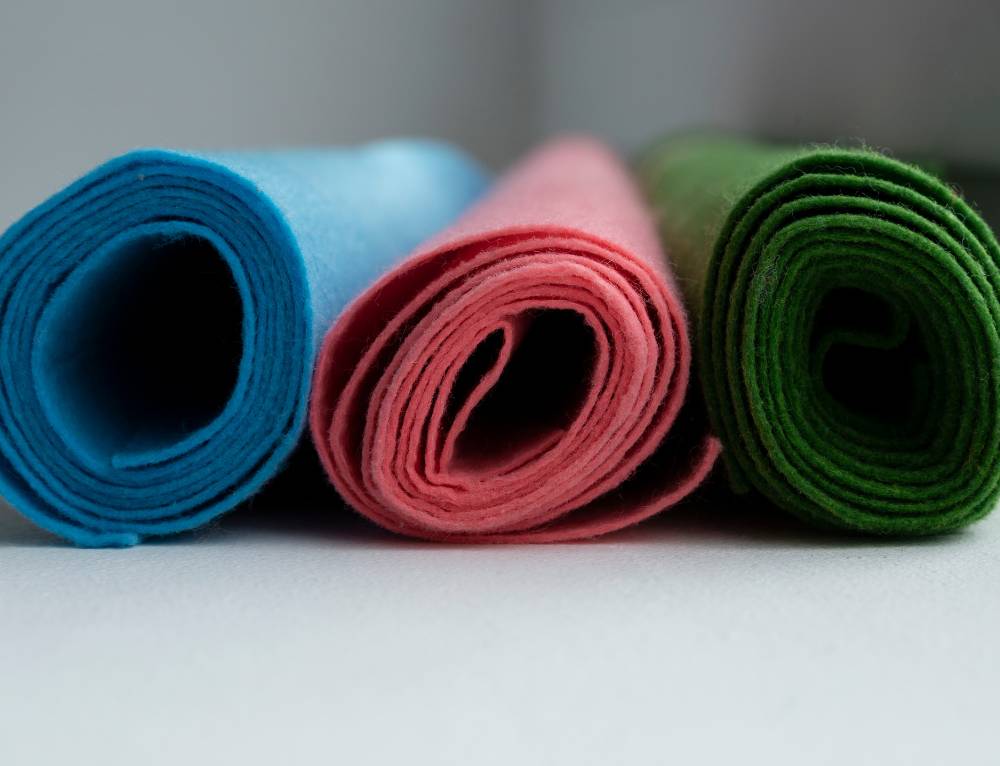
Various yoga mats in different materials and colors are arranged side by side in a yoga studio, showcasing options like rubber, cork, and foam.
Choosing the Right Thickness
The thickness of a yoga mat is another crucial factor in choosing the perfect yoga mat for your practice. Mats typically range from 1/16 inch (about 1.5mm) to 1/4 inch (about 6mm) thick, with some mats offering extra padding. The right thickness for you will depend on your practice style and personal preferences.
- Thin Mats (1/16 inch): These are ideal for practices that require balance and grounding, such as Vinyasa or Ashtanga yoga. They allow you to feel more connected to the floor, which can enhance stability.
- Standard Mats (1/8 inch): The most common thickness, standard mats offer a balance between comfort and stability. They are suitable for most types of yoga.
- Thick Mats (1/4 inch or more): If you need extra cushioning, thick mats are a great choice. They are especially beneficial for restorative yoga or for practitioners with sensitive joints. However, they may compromise stability during standing poses.
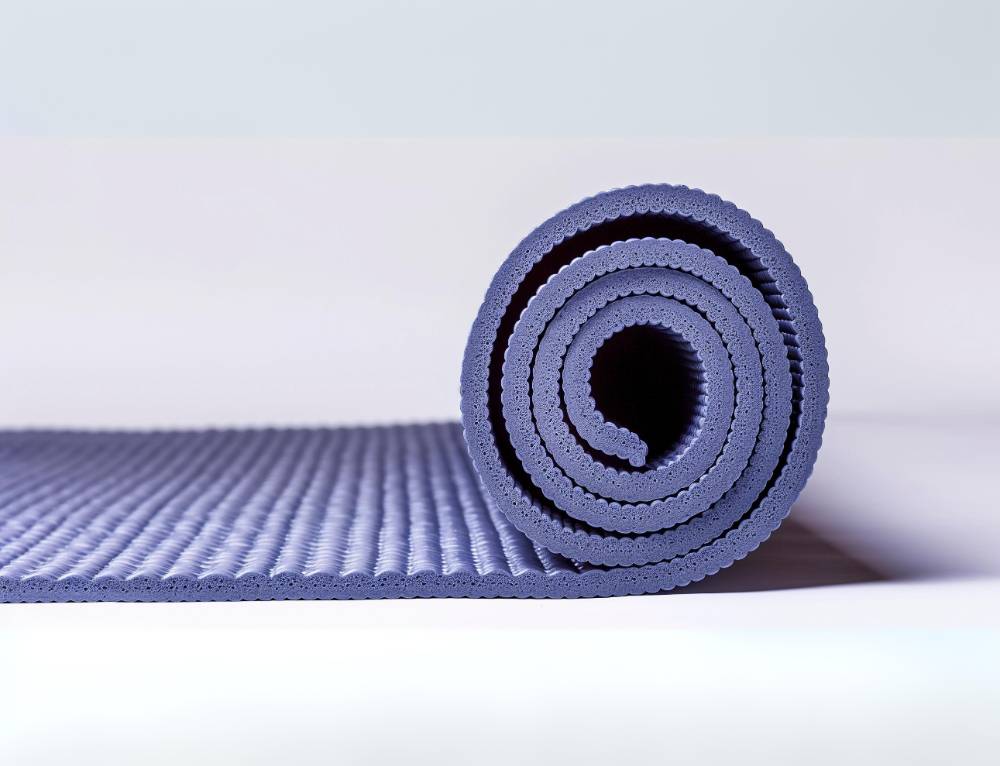
Material Considerations
When choosing the perfect yoga mat for your practice, the material is a critical consideration. The material affects everything from the mat’s durability to its environmental impact.
- Natural vs. Synthetic: Natural materials like rubber, jute, and cork are biodegradable and generally more sustainable than synthetic options like PVC and TPE. However, synthetic mats often offer better durability and grip.
- Texture and Grip: The texture of a yoga mat can influence its grip. Mats with a rougher texture tend to offer better grip, which is crucial for maintaining stability in poses. If you practice hot yoga or tend to sweat a lot, look for a mat with a textured surface to prevent slipping.
Eco-Friendly Yoga Mats
Eco-conscious consumers should consider the environmental impact of their yoga mat. Fortunately, many brands now offer eco-friendly options that don’t sacrifice performance for sustainability.
- Sustainable Choices: Materials like natural rubber, jute, and cork are renewable and biodegradable, making them excellent choices for those looking to reduce their carbon footprint. These mats are often free from harmful chemicals and dyes, contributing to a healthier practice environment.
- Advantages of Eco-Friendly Mats: Besides being better for the planet, eco-friendly mats often provide a more natural feel and superior grip. They may also be less likely to emit odors or cause allergic reactions, making them a safer choice for sensitive individuals.
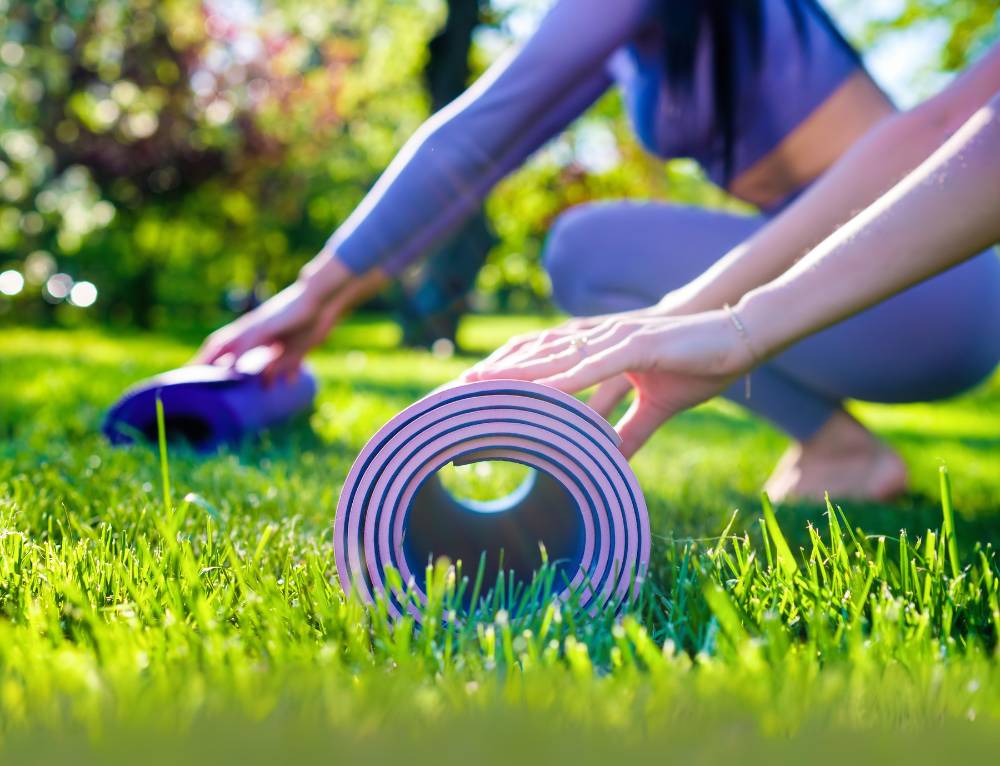
Texture and Grip
One of the most important factors to consider when choosing the perfect yoga mat for your practice is the texture and grip. The mat’s texture can significantly influence your stability, especially in poses that require a firm footing.
- Finding the Right Surface Feel: Mats with a smooth surface may feel more comfortable, but they can become slippery when you sweat. On the other hand, mats with a raised texture can help prevent slipping and provide better traction. This is particularly important for styles of yoga that involve a lot of movement, such as Vinyasa or Power yoga.
Portability and Weight
Portability is another crucial aspect to consider, especially if you plan to carry your mat to and from the studio. The weight of the mat is often determined by its material and thickness.
- Balancing Convenience with Functionality: Lightweight mats made from TPE or thin PVC are easier to carry and store, making them ideal for travel or on-the-go practice. However, they may not offer the same level of comfort and stability as heavier, thicker mats.
Durability and Lifespan
When investing in a yoga mat, it’s essential to consider its durability and lifespan. A good mat should withstand regular use without deteriorating quickly.
- How Long Should Your Mat Last?: The lifespan of your mat will depend on the material and how often you use it. PVC mats, for example, are known for their durability and can last several years with proper care. Natural mats, while more eco-friendly, may wear out more quickly, especially if used frequently.
Price vs. Quality
When choosing the perfect yoga mat for your practice, it’s important to strike a balance between price and quality. While it might be tempting to go for the cheapest option, investing in a high-quality mat can make a significant difference in your practice.
- Is it Worth Investing in a High-End Mat?: High-end mats often offer better grip, durability, and comfort. They are also more likely to be made from eco-friendly materials. While the upfront cost may be higher, the long-term benefits often outweigh the initial investment.
Personal Style and Aesthetics
Your yoga mat is an extension of your practice, and for many, it’s also an expression of personal style.
- Choosing a Mat That Matches Your Personality: From vibrant colors to intricate designs, the aesthetics of your mat can influence your motivation and enjoyment during practice. Whether you prefer a minimalist design or a bold pattern, there’s a mat out there that reflects your unique personality.
Specialty Yoga Mats
For those who practice specific styles of yoga, specialty mats might be the best choice.
- Mats for Hot Yoga, Travel, and More: Hot yoga mats, for example, are designed to absorb sweat and maintain grip even in humid conditions. Travel mats are lightweight and easy to fold, making them convenient for yogis on the go. If you have specific needs, there’s likely a mat tailored to your practice.
Brand Comparisons
With so many brands on the market, it can be challenging to know which one offers the best yoga mat for your practice.
- Popular Brands and Their Offerings: Brands like Manduka, Liforme, and Gaiam are well-known for their quality yoga mats. Each brand has its strengths, whether it’s durability, eco-friendliness, or aesthetics. Comparing these brands can help you make an informed decision.
Allergies and Sensitivities
If you have allergies or sensitivities, choosing the perfect yoga mat for your practice requires extra attention to the materials used.
- Mats for Those with Allergies: Latex-free mats are essential for those with latex allergies, while mats made from natural materials may be less likely to cause skin irritations. Always check the mat’s composition before purchasing to ensure it’s safe for your needs.
Maintaining Your Yoga Mat
To ensure your mat lasts as long as possible, proper maintenance is key.
- Cleaning and Care Tips for Longevity: Regularly cleaning your mat can prevent the buildup of sweat and bacteria, which can cause odors and wear down the material. Use a mild soap and water solution, and allow the mat to air dry completely before rolling it up.
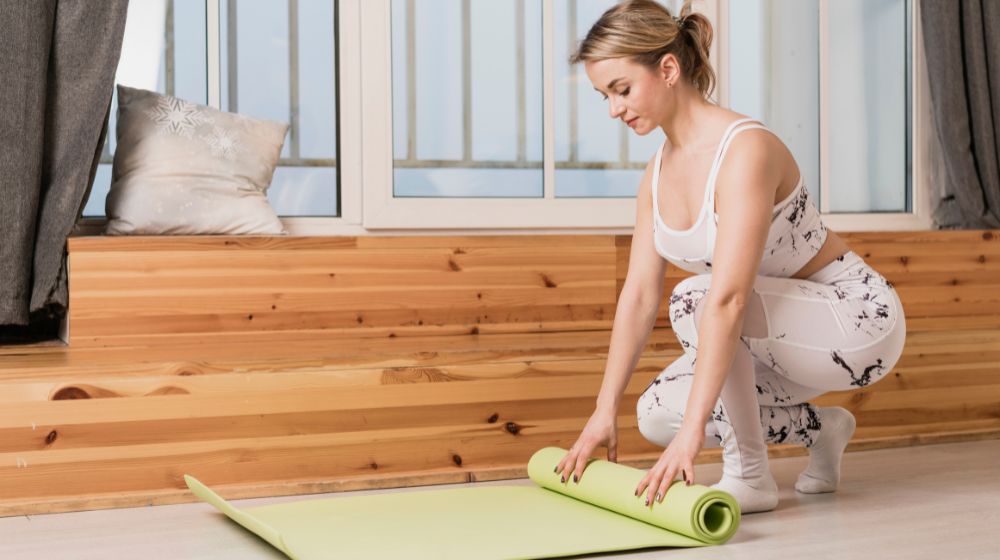
When to Replace Your Yoga Mat
Even the best mats eventually wear out and need to be replaced.
- Signs It’s Time for a New Mat: If your mat has lost its grip, has visible signs of wear, or no longer provides adequate cushioning, it’s time to invest in a new one. Continuing to use a worn-out mat can lead to discomfort and increase the risk of injury.
Reviews and Testimonials
Hearing from others can be a great way to determine if a mat is right for you.
- What Others Are Saying About Their Mats: Many yoga practitioners share their experiences with different mats online. Reading reviews and testimonials can provide insight into the mat’s performance, durability, and overall value.
Buying Your First Yoga Mat
If you’re new to yoga, buying your first mat can be overwhelming.
- A Guide for Beginners: Start by considering the type of yoga you plan to practice, your budget, and your personal preferences. Look for a mat that offers a good balance of comfort and stability, and don’t be afraid to ask for recommendations from more experienced yogis.
Budget-Friendly Options
You don’t have to break the bank to find a quality yoga mat.
- Affordable Mats That Don’t Compromise Quality: There are plenty of budget-friendly options available that offer good grip, durability, and comfort. Look for mats made from TPE or standard PVC, which tend to be more affordable without sacrificing performance.
Premium Yoga Mats
For those who want the best of the best, premium yoga mats are worth considering.
- What Sets Luxury Mats Apart: Premium mats often feature superior materials, such as natural rubber or eco-friendly TPE. They may also offer extra cushioning, enhanced grip, and unique designs. If you’re serious about your practice, a premium mat can be a worthwhile investment.
Best Mats for Different Practices
Not all yoga mats are created equal, and some are better suited to specific styles of yoga.
- Tailoring Your Mat to Your Yoga Style: For instance, a thicker mat may be better for restorative yoga, while a mat with a strong grip is essential for Power yoga. Consider your practice style when choosing a mat to ensure it meets your needs.
Yoga Mat Accessories
Enhance your practice with the right accessories.
- Enhancing Your Practice with the Right Gear: From carrying straps to mat bags and cleaning sprays, the right accessories can make transporting and maintaining your mat easier. Some accessories, like knee pads, can also provide additional comfort during practice.
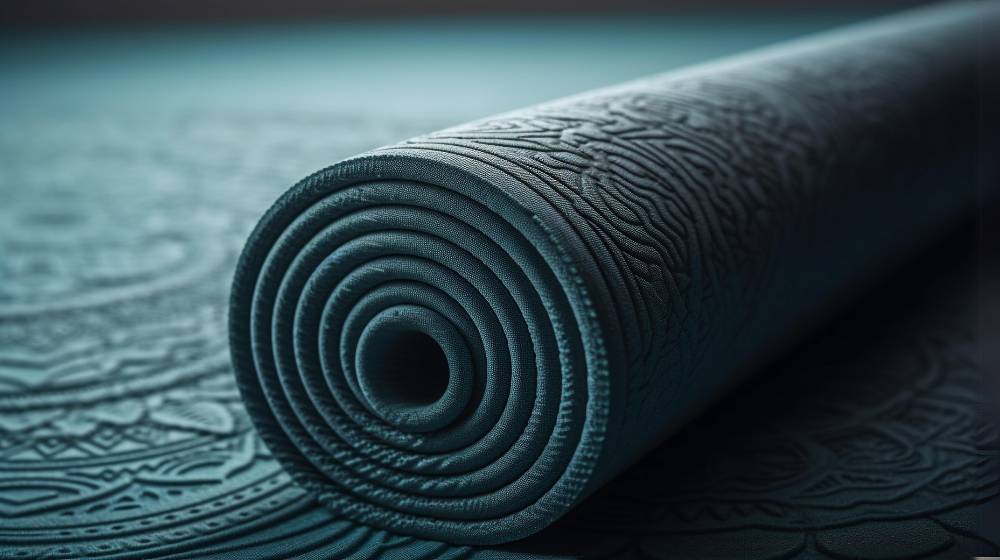
The Impact of Mat Color
Believe it or not, the color of your yoga mat can influence your practice.
- How Color Influences Mood and Practice: Colors can affect your mood and energy levels. For example, calming colors like blue and green can enhance relaxation, while vibrant colors like red and orange can energize your practice. Choose a color that resonates with your intentions for your practice.
Yoga Mat Storage Solutions
Proper storage can help extend the life of your mat.
- Keeping Your Mat in Top Condition: Store your mat in a cool, dry place away from direct sunlight to prevent fading and deterioration. Using a mat bag can protect it from dust and damage when not in use.
Frequently Asked Questions
The best thickness for a yoga mat depends on your practice style and personal comfort. Standard mats (1/8 inch) offer a good balance for most practitioners.
It’s recommended to clean your yoga mat after every few uses, especially if you sweat a lot during practice. Regular cleaning helps maintain hygiene and extend the mat’s lifespan.
Yes, eco-friendly yoga mats made from natural materials like rubber or jute can be quite durable, especially with proper care.
The most important feature depends on your priorities. Grip, thickness, and material are all key factors to consider based on your practice style and personal preferences.
Yes, many mats are versatile enough to be used for various styles of yoga. However, if you practice a specific style like hot yoga, you might benefit from a specialty mat.
Replace your yoga mat if it has lost its grip, is visibly worn, or no longer provides adequate cushioning. A worn-out mat can lead to discomfort and increase the risk of injury.

